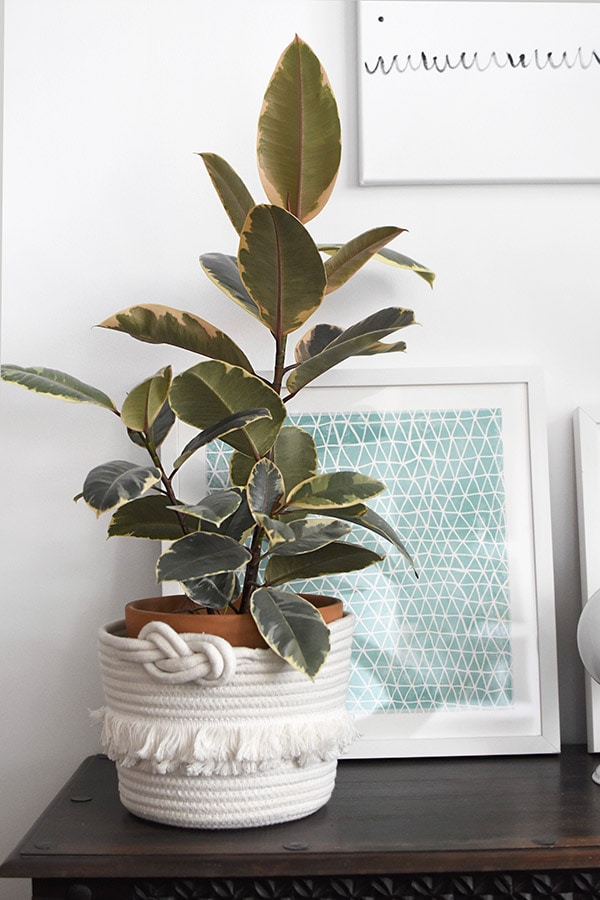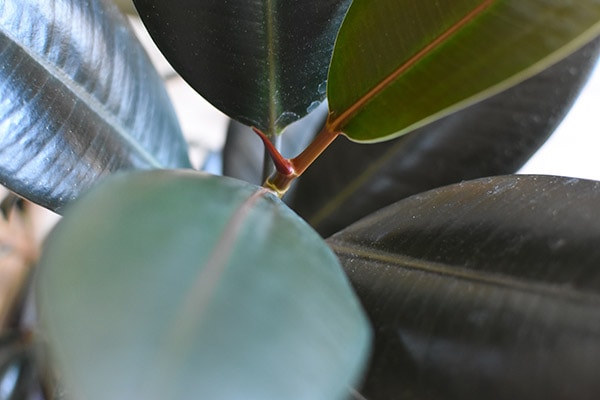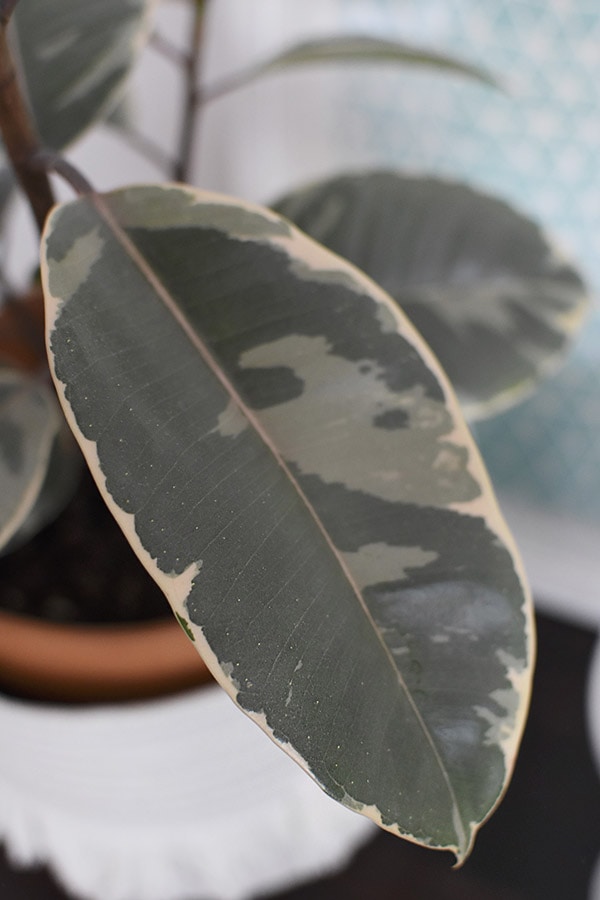Rubber Plant Care + Tips
INSIDE : Learn the best practices on how to care for your Rubber Plants! Helpful Rubber Plant Care + tips, from watering needs, light requirements, grow big healthy Ficus elastica.

This post may contain affiliate links. See full disclosure here.
Rubber Plants or if you know them by their latin name, Ficus Elastica are a gorgeous and fairly simple indoor houseplant to own. I even included them in my 11 Hard to Kill Houseplants list!
I currently have two of them; a Burgundy Rubber Plant and a slightly older Pink Variegated Rubber Plant. I’m not sure I could pick a favorite if I had to because they both have such stunning leaves!
Variegated Rubber Plant leaves vs. Dark Green Rubber Plant leaves
The variegated Rubber Plants have the coolest leaves. They are usually white and different shades of green, but some portions of pink, like mine. The variegated ones are more sensitive to direct sunlight and have a harder time producing chlorophyll, so they can grow at a slower rate than the darker green plants.

I have learned so much about Rubber Plants over the last year and I can’t wait to share my best care tips with you!
But first, if you like this post about Rubber Plant care, then you will definitely enjoy my indoor houseplant care ebook, Happy Houseplants!
My Happy Houseplants ebook talks about how to not kill all the plants and includes:
– A super helpful checklist for 6 steps to keep your plants alive + thriving.
– A deep dive on 7 trending “it” plants (like your finicky Fiddle Leaf Fig!)
-5 plant printables to hang in your home.
How do you take care of a Ficus elastica plants?
What are the best growing conditions for Rubber plants?
Rubber Plants have big beautiful leaves and unfortunately those leaves can get dusty pretty quickly. Be sure to keep leaves clean and dust-free by wiping with a soft cloth about once a month. You can read my how to clean your houseplants post for tons of helpful tips. And every few weeks, I give my plant’s leaves a light mist. I use this spray bottle and leave it out on the counter because it’s so pretty.

Rubber Plants are strong growers and they can grow to very tall heights within a few years. However, if you keep the plant in a smaller pot, it will help to restrict their growth.
How often should I water a Rubber plant?
When you notice the soil has become dry on your Rubber Plant, it is time to do the good ole’ finger test. Stick your finger down about an inch or two and feel the soil. If it is dry, then you can safely water your plant.
I have noticed that during the warmer summer months, that my Rubber Plants need watering about once a week. I have all my plants on a Friday watering schedule which means that each Friday I walk around and check on the soil moisture of my plants. If they are dry, then they get a drink. Also leaves that droop or hang down are a sign the plant is thirsty and needs a drink.

When you are watering your Rubber Plants, make sure to thoroughly wet the soil until water drains into the plant dish from the bottom of your pot. Once the water has sat in the dish for about 15 minutes, you can safely assume no more water will be reabsorbed and you can dump the remaining water from the dish.
During the cooler times of the year, your plant may only need water once or twice a month. Still keep your plant on a Friday schedule and check the soil moisture. If it’s not dry, then you can skip watering for that week. Leaves that turn yellow and brown and drop signal over-watering.
Should I mist my Rubber Plant if I live in a dry climate with low humidity?
I have had many people ask about misting your plants. Here is the scoop on misting plants – I totally do it whenever I randomly remember. So, it’s not that often. Does misting your plants help bring up the humidity for your plants? Yes – for about 10 seconds and then it’s back to the dry conditions, ha. Is it bad to spray your plants with a water bottle? Not at all. I think of it almost like cleaning off my leaves from dust by giving them a quick spritz. Not bad to do, but not essential.
Do Rubber Plants need direct sunlight?
Rubber Plants thrive in medium to bright indirect light, but can tolerate some bright direct light. Check out my post for Best Sunlight Levels for your plants.

The darker colored Rubber Plants will do best with consistent, bright, filtered light—which produces the dark, burgundy color of the leaves. A sunny spot shielded by a sheer curtain is often perfect for rubber plants. You can tell if your rubber plant needs more light if it starts becoming more leggy or you start noticing the lower leaves falling off.
What supplies do I need to grow a Rubber Plant?
Plant Moisture Meter | Pruning Shears | 6″ Pot Rubber Plant | Pot | Spray Bottle
Why are they called Rubber Plants?
The latex sap in Rubber Plants is from the amount of isoprene it produces and was once used to make rubber before synthetics and other natural alternatives became available.

In India, the Rubber Plant’s roots are used to make living bridges. A rotting tree trunk is put across a river, and the rubber tree’s roots are guided along the trunk, eventually growing to the other side, and thickening to complete the bridge. The bridge, being alive and flexible, resists wind and flooding.
Love plants like I do? You might like some of my other Plant Care + Tip posts.
How fast do Rubber Plants grow?
Rubber Plants are fast growers. If in their ideal conditions, they can grow as much as 24″ in one season! However, once your plant has reached the height you want it at, you can snip off the top of the plant.

How to propagate Rubber Plants :
If you are looking to propagate Rubber Plants, the process is fairly simple. You can cut a leaf off of your plant near a node, the small bump you may see on the main stem. You will need to make sure you have more than JUST a leaf, getting a node and some stem is essential for the plant to grow new roots.

Once you have your cutting, you can place it in a glass or vase of water and place it near indirect sunlight. You can read more about water propagation for plants here.
My Rubber Plant has water stains on the leaves. How can I safely remove them?
After you own an indoor houseplant for a while, you may start to see water stains on your leaves that slowly builds up from tap water. If you wipe the water stains away by simply using water, you will notice they go away and after the leaf dries – the stain comes right back.
To get rid of those water stains, you need to make a simple acidic mixture to clean off the leaf. Fill a glass with filtered water, if possible, and then add equal parts lime or lemon juice. You can either squeeze a lime or lemon or just use the pre-squeezed bottle lime or lemon juice.
Next, grab a microfiber cloth and dip into your water/citrus mixture. Gently wipe away those stains! You can also use essential oils to replace the lime or lemon juice if you prefer an oil route.
Are Rubber Plants poisonous?
Rubber Plants are considered poisonous. The milky sap that they produce contains Latex that can be harmful to human and animals. But there is no need to hugely become concerned, the sap can cause minor skin irritation to larger rashes. But typically does not harm more than that.
My Rubber Plant is leggy. Is that okay?
There are a few reasons that Rubber Plants get leggy. First of all, if your plant is leggy it might be an indication of a lack of sunlight. The plant may be growing tall and skinny to try and reach it’s leaves up closer to a sun source.
The other reason your plant is getting leggy is because they are not self supporting. The taller your Rubber Plant grows, they heavier they get. As they grow, you can use a bamboo stake to help keep your plant more upright.
My Rubber Plant leaves are droopy. What should I do?
Typically droopy leaves on a Rubber Plant are an indication that your plant probably needs more water. Try to move your plant onto a weekly watering schedule and see if your plant’s leaves start to improve!
Where to buy Rubber Plants?
I’m so glad you are excited to buy yourself a Rubber Plant, they are just the best! Typically most local nurseries carry many Rubber plant varieties. However, they are an easy plant to purchase online, too. The Sill carries a potted Rubber Plant that is gorgeous . I’ve seen numerous shops on Etsy (Pink species) carrying them. And I love that Amazon is now selling many different types of them, too.

You might be interested in some of my other Plant Care posts:






